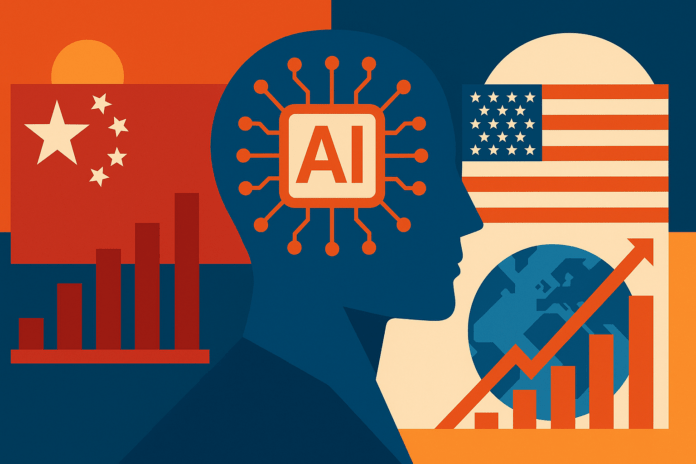Artificial intelligence ceased to be merely a field of technological research long ago. It has become a strategic axis of global competition, with far-reaching implications across science, economics, and politics. According to the picture outlined by the 2025 AI Index Report, AI thinks Chinese but acts American. On the global stage, the center of scientific production is shifting eastward: in 2023, the Asia-Pacific region accounted for over a third of the world’s AI publications (34.5%), with China leading at over 23%—well ahead of the United States (9.2%) and Europe (15.2%).
On the production side, however, the balance shifts. In 2024, the United States generated 40 of the so-called notable AI models, compared to China’s 15. Since 2003, no other country has produced more cutting-edge innovations. This technical leadership is matched by financial dominance: with over $109 billion invested in 2024 alone (a +50.7% increase from the previous year), the U.S. confirms its role as the economic epicenter, compared to $9.3 billion in the Chinese market (a -1.9% decrease). Europe performs slightly better, with over $19 billion in investments (+60%).
The geopolitical landscape of AI, however, is made far more complex by a supply chain that spans multiple continents and involves—not just the two superpowers—but also numerous other nations such as India, Taiwan, Mexico, Malaysia, South Korea, Japan, the United Kingdom, and the European Union.
We discuss this with Alessandro Aresu – writer, consultant, and expert in public policy, strategy, and geopolitics – as well as author of the recently published essay “Geopolitica dell’intelligenza artificiale”.
How does the race for AI fit into the current geopolitical context?
We have long been living through a process I define as “political capitalism”, in which the competition between the United States and China—at least since the launch of China’s Made in China 2025 plan in 2015—has led to an increasing intertwining of market goals and political objectives, with national security expanding into various technological sectors.
If we follow the trajectory of major global tech companies over the past decade—studying, for example, entities like ASML, BYD, DeepMind, NVIDIA, Palantir, and TSMC—we increasingly see that they must take political issues and geopolitical risks into account, from tariffs and sanctions to export controls.
Artificial intelligence is fully embedded in this dynamic and cannot be understood outside of this broader context.
What’s at stake geopolitically?
First of all, artificial intelligence is not a separate domain, but part of the broader evolution of digitalization and the semiconductor industry. To “build” AI, we need what NVIDIA has long described as “factories of artificial intelligence”—that is, data centers, a concept the company has developed over many years and which has led to the creation of its advanced systems.
At the same time, these data centers depend on “factories of the factories of artificial intelligence”: the places where semiconductors are produced—such as Taiwan Semiconductor Manufacturing Company—along with Korean and U.S. memory manufacturers, Taiwanese assemblers, the chemical industry, industrial gases, steel, copper, energy, and much more.
The control and organization of this supply chain, which is far more complex than that of software companies, is the central and most critical issue.
The main drivers of geopolitical dynamics are the geography of talent—that is, where STEM talents are educated, in which universities or research centers they work, and which companies they join—and the structure of computing infrastructures: namely, the full range of capabilities tied to the semiconductor industry, its ecosystem, and the development of data centers.
The main competitors today are the U.S. and China: what are their goals?
Technological leadership—in so-called foundational or emerging technologies—has always gone hand in hand with political leadership in the international system.
Each of the major contenders is therefore pursuing the AI race to maintain or enhance its global standing, as well as to ensure the deployment of these technologies in military and industrial domains.
This is true for both the United States and China—despite their very different political systems—but it also applies to other players, such as India and the Gulf monarchies, for example.
What are the strengths and weaknesses of the two superpowers?
As I also point out in my book—where I go into more detail—the U.S. has a stronger ability to attract talent and capital.
China, on the other hand, is the world’s largest producer of talent and is an industrial power far superior to the U.S.—and industrial capacity still matters, even in this field.
Beyond these two, India is also a major player in the global talent landscape. Just look at the number of university students, managers, and entrepreneurs of Indian origin in the United States.
In this scenario—where strengths and weaknesses differ—it’s hard to imagine one side gaining any kind of definitive leadership, especially in an increasingly complex and fragmented world.
In all this, the European Union remains significantly behind—more focused on setting rules than on advancing technological development. Is that a good strategy?
Essentially, it’s a pointless strategy. Not necessarily harmful, but pointless—because the idea that Europe’s regulatory capacity has real global influence is simply false, and certainly overestimated.
I’ve written about this many times: I’ve explained everything there is to know about Europe’s position in the technological race.
Competition is about talent, capital, and companies—so what matters are the regulations that affect those three factors. The rest is just noise.
Europe is already a region in decline in this century. So unless it improves in those three areas, the decline will only deepen. Period.
Is a full-blown confrontation really possible in such an interconnected world?
It’s very difficult—but it’s still being pursued. The result is a series of bold moves, often later revised or adjusted, aimed at reshaping the geography of value chains—because that very geography holds political value.
We’ve already seen this during the first Trump administration, with the reduction of some areas of direct exchange between Beijing and Washington, and the growing importance of alternative production and trade geographies—first and foremost, Southeast Asian countries like Vietnam and Malaysia, as well as Mexico, which is playing an increasingly central role, and of course India.
One essential point to understand is that a full-scale U.S. trade war against the entire world is essentially impossible—just as a complete and consistent reindustrialization of the United States is unlikely.
What can happen, however, is a push toward value chains that aim to exclude—though with difficulty—China, along with the reshoring of certain production segments back to the U.S.
What are the most likely global scenarios for the future?
The Silicon Valley crowd will keep throwing out “decisive dates”—like 2027—with the sole aim of making money, and with a fair amount of success.
Meanwhile, artificial intelligence will remain a complex and multifaceted supply chain, where what really matters is control over its key nodes and its diffusion across various industrial sectors.
The data center economy won’t be able to sustain the same growth rates indefinitely, so companies will increasingly shift toward robotics and its many applications—as we’re already seeing—but also toward biotechnology.
In any case, the driving forces behind this process will remain the same: talent, companies, capital.
In this context, what should life science companies expect?
First of all, as demonstrated by the 2024 Nobel Prize in Chemistry awarded to Demis Hassabis and others for AlphaFold, it’s clear that biology and biotechnology are already areas of significant interest for companies working in artificial intelligence.
For life science companies, the key issue to monitor is how scientific breakthroughs might translate into commercial returns. That means keeping a close eye on initiatives like Isomorphic Labs—a subsidiary of Alphabet (Google’s parent company) founded in 2021 to turn DeepMind innovations, especially AlphaFold, into real-world drug discovery solutions.
It also means paying attention to the promises of the Stargate Project—a joint venture launched this year by OpenAI, SoftBank, Oracle, and the MGX fund, aiming to invest up to $500 billion in AI infrastructure over the next four years.
NVIDIA, the leading force in the AI ecosystem, is already making major investments in life sciences—this alone shows just how crucial the field has become.


